UPU0002 Essay: Analyzing Rurality as a Health Risk in Australia
VerifiedAdded on 2023/06/18
|7
|1718
|193
Essay
AI Summary
This essay examines the health risks associated with rurality in Australia, highlighting the disparities in healthcare access and outcomes compared to metropolitan areas. It discusses factors such as the shortage of healthcare professionals, economic stagnation, and social determinants like income and education that contribute to poorer health in rural communities. The essay also addresses the challenges in accessing specialized medical services and the impact of cultural differences on healthcare management. It concludes that rurality poses a significant health risk in Australia, emphasizing the need for improved resource allocation, enhanced training for healthcare providers, and the implementation of targeted strategies to address the unique healthcare needs of rural populations. The essay references various scholarly articles to support its arguments and provides a comprehensive overview of the issues affecting rural healthcare in Australia.
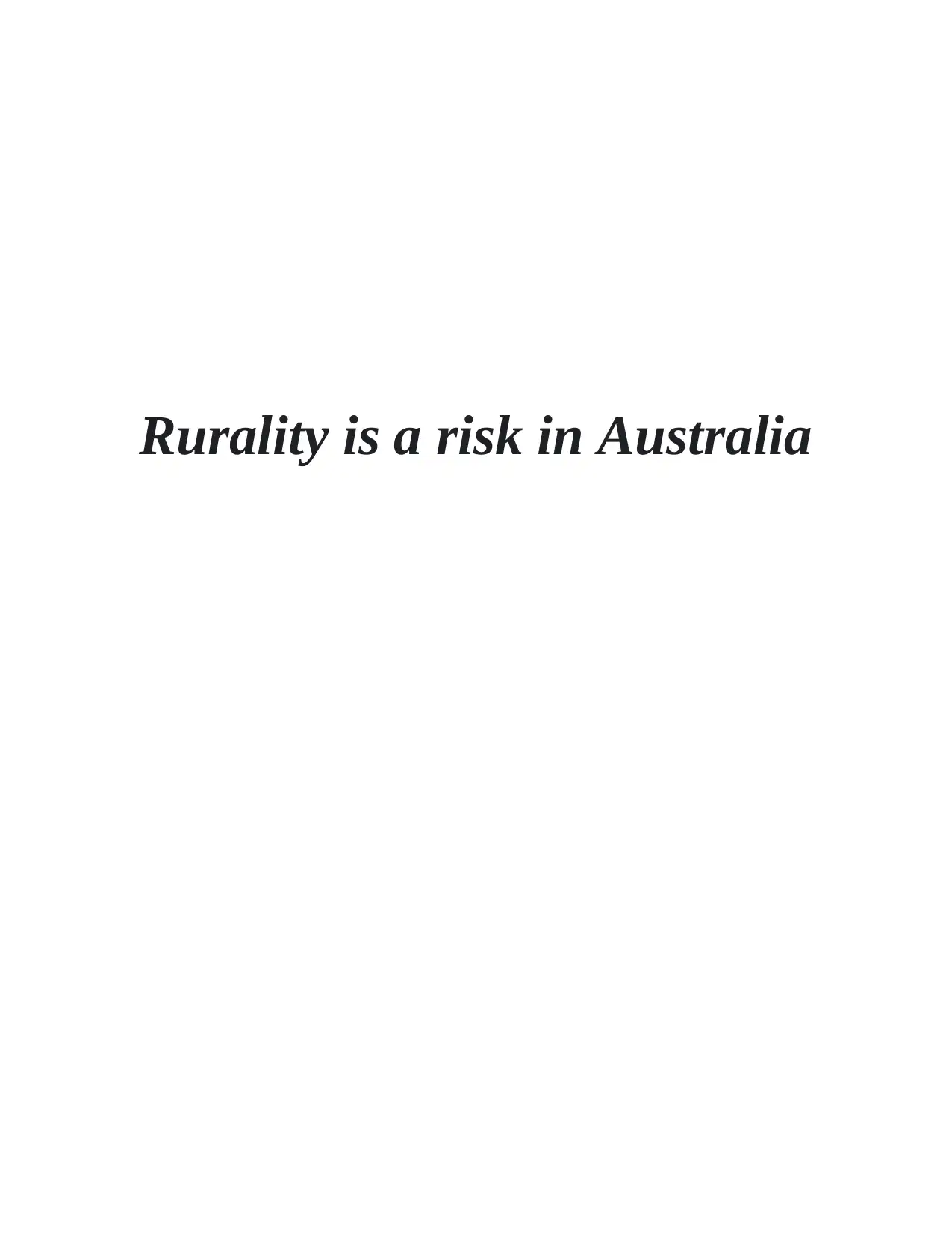
Rurality is a risk in Australia
Paraphrase This Document
Need a fresh take? Get an instant paraphrase of this document with our AI Paraphraser
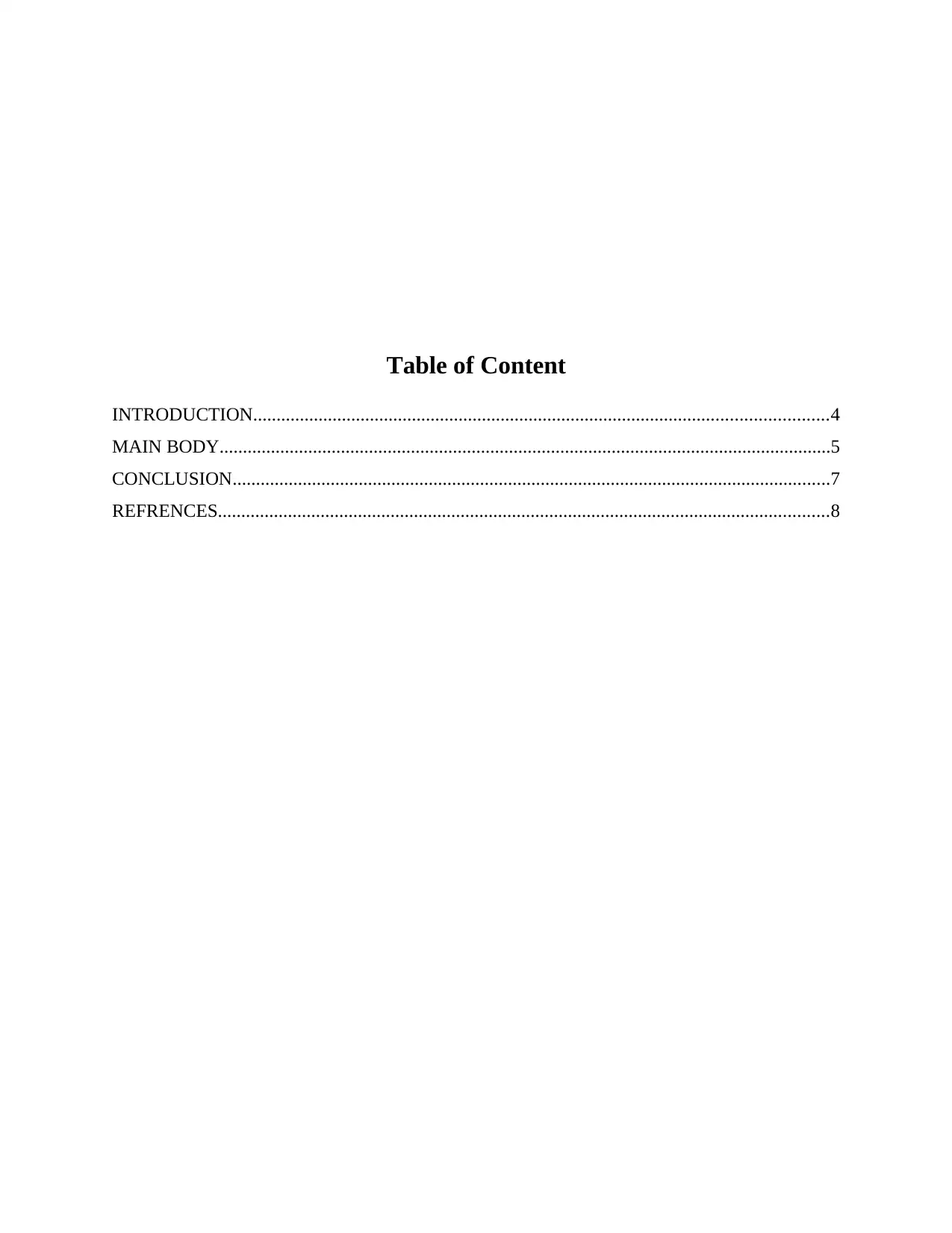
Table of Content
INTRODUCTION...........................................................................................................................4
MAIN BODY...................................................................................................................................5
CONCLUSION................................................................................................................................7
REFRENCES...................................................................................................................................8
INTRODUCTION...........................................................................................................................4
MAIN BODY...................................................................................................................................5
CONCLUSION................................................................................................................................7
REFRENCES...................................................................................................................................8
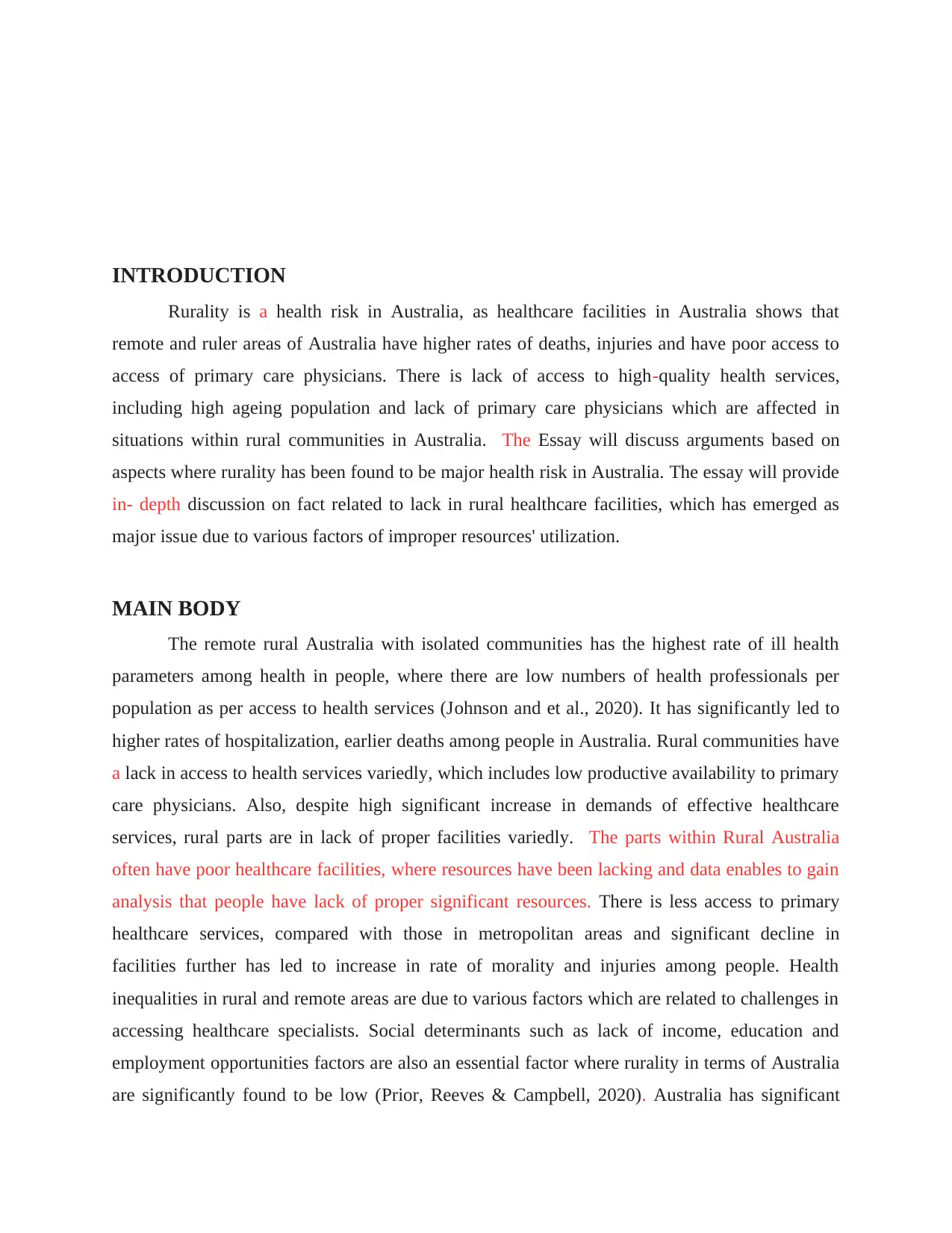
INTRODUCTION
Rurality is a health risk in Australia, as healthcare facilities in Australia shows that
remote and ruler areas of Australia have higher rates of deaths, injuries and have poor access to
access of primary care physicians. There is lack of access to high-quality health services,
including high ageing population and lack of primary care physicians which are affected in
situations within rural communities in Australia. The Essay will discuss arguments based on
aspects where rurality has been found to be major health risk in Australia. The essay will provide
in- depth discussion on fact related to lack in rural healthcare facilities, which has emerged as
major issue due to various factors of improper resources' utilization.
MAIN BODY
The remote rural Australia with isolated communities has the highest rate of ill health
parameters among health in people, where there are low numbers of health professionals per
population as per access to health services (Johnson and et al., 2020). It has significantly led to
higher rates of hospitalization, earlier deaths among people in Australia. Rural communities have
a lack in access to health services variedly, which includes low productive availability to primary
care physicians. Also, despite high significant increase in demands of effective healthcare
services, rural parts are in lack of proper facilities variedly. The parts within Rural Australia
often have poor healthcare facilities, where resources have been lacking and data enables to gain
analysis that people have lack of proper significant resources. There is less access to primary
healthcare services, compared with those in metropolitan areas and significant decline in
facilities further has led to increase in rate of morality and injuries among people. Health
inequalities in rural and remote areas are due to various factors which are related to challenges in
accessing healthcare specialists. Social determinants such as lack of income, education and
employment opportunities factors are also an essential factor where rurality in terms of Australia
are significantly found to be low (Prior, Reeves & Campbell, 2020). Australia has significant
Rurality is a health risk in Australia, as healthcare facilities in Australia shows that
remote and ruler areas of Australia have higher rates of deaths, injuries and have poor access to
access of primary care physicians. There is lack of access to high-quality health services,
including high ageing population and lack of primary care physicians which are affected in
situations within rural communities in Australia. The Essay will discuss arguments based on
aspects where rurality has been found to be major health risk in Australia. The essay will provide
in- depth discussion on fact related to lack in rural healthcare facilities, which has emerged as
major issue due to various factors of improper resources' utilization.
MAIN BODY
The remote rural Australia with isolated communities has the highest rate of ill health
parameters among health in people, where there are low numbers of health professionals per
population as per access to health services (Johnson and et al., 2020). It has significantly led to
higher rates of hospitalization, earlier deaths among people in Australia. Rural communities have
a lack in access to health services variedly, which includes low productive availability to primary
care physicians. Also, despite high significant increase in demands of effective healthcare
services, rural parts are in lack of proper facilities variedly. The parts within Rural Australia
often have poor healthcare facilities, where resources have been lacking and data enables to gain
analysis that people have lack of proper significant resources. There is less access to primary
healthcare services, compared with those in metropolitan areas and significant decline in
facilities further has led to increase in rate of morality and injuries among people. Health
inequalities in rural and remote areas are due to various factors which are related to challenges in
accessing healthcare specialists. Social determinants such as lack of income, education and
employment opportunities factors are also an essential factor where rurality in terms of Australia
are significantly found to be low (Prior, Reeves & Campbell, 2020). Australia has significant
⊘ This is a preview!⊘
Do you want full access?
Subscribe today to unlock all pages.

Trusted by 1+ million students worldwide
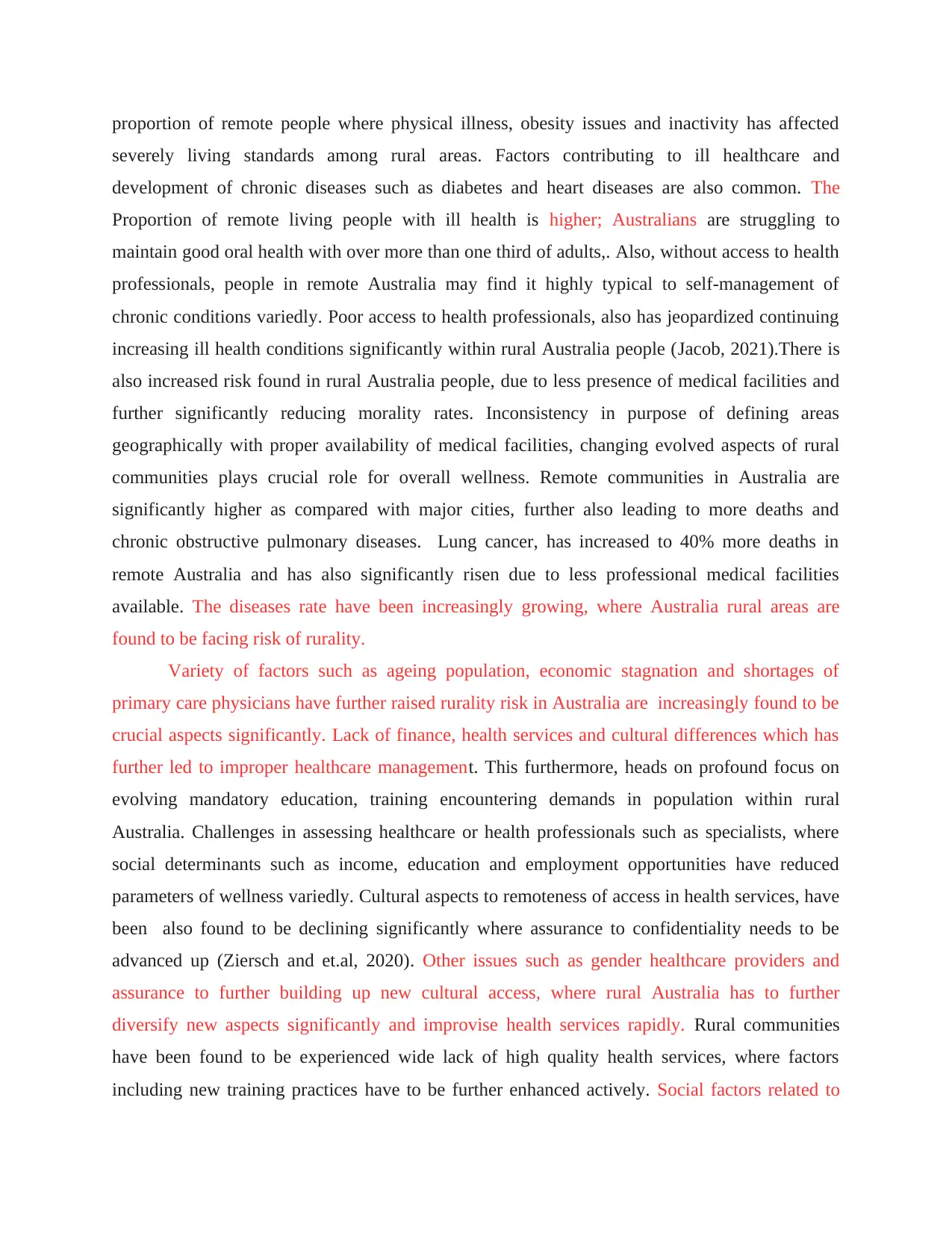
proportion of remote people where physical illness, obesity issues and inactivity has affected
severely living standards among rural areas. Factors contributing to ill healthcare and
development of chronic diseases such as diabetes and heart diseases are also common. The
Proportion of remote living people with ill health is higher; Australians are struggling to
maintain good oral health with over more than one third of adults,. Also, without access to health
professionals, people in remote Australia may find it highly typical to self-management of
chronic conditions variedly. Poor access to health professionals, also has jeopardized continuing
increasing ill health conditions significantly within rural Australia people (Jacob, 2021).There is
also increased risk found in rural Australia people, due to less presence of medical facilities and
further significantly reducing morality rates. Inconsistency in purpose of defining areas
geographically with proper availability of medical facilities, changing evolved aspects of rural
communities plays crucial role for overall wellness. Remote communities in Australia are
significantly higher as compared with major cities, further also leading to more deaths and
chronic obstructive pulmonary diseases. Lung cancer, has increased to 40% more deaths in
remote Australia and has also significantly risen due to less professional medical facilities
available. The diseases rate have been increasingly growing, where Australia rural areas are
found to be facing risk of rurality.
Variety of factors such as ageing population, economic stagnation and shortages of
primary care physicians have further raised rurality risk in Australia are increasingly found to be
crucial aspects significantly. Lack of finance, health services and cultural differences which has
further led to improper healthcare management. This furthermore, heads on profound focus on
evolving mandatory education, training encountering demands in population within rural
Australia. Challenges in assessing healthcare or health professionals such as specialists, where
social determinants such as income, education and employment opportunities have reduced
parameters of wellness variedly. Cultural aspects to remoteness of access in health services, have
been also found to be declining significantly where assurance to confidentiality needs to be
advanced up (Ziersch and et.al, 2020). Other issues such as gender healthcare providers and
assurance to further building up new cultural access, where rural Australia has to further
diversify new aspects significantly and improvise health services rapidly. Rural communities
have been found to be experienced wide lack of high quality health services, where factors
including new training practices have to be further enhanced actively. Social factors related to
severely living standards among rural areas. Factors contributing to ill healthcare and
development of chronic diseases such as diabetes and heart diseases are also common. The
Proportion of remote living people with ill health is higher; Australians are struggling to
maintain good oral health with over more than one third of adults,. Also, without access to health
professionals, people in remote Australia may find it highly typical to self-management of
chronic conditions variedly. Poor access to health professionals, also has jeopardized continuing
increasing ill health conditions significantly within rural Australia people (Jacob, 2021).There is
also increased risk found in rural Australia people, due to less presence of medical facilities and
further significantly reducing morality rates. Inconsistency in purpose of defining areas
geographically with proper availability of medical facilities, changing evolved aspects of rural
communities plays crucial role for overall wellness. Remote communities in Australia are
significantly higher as compared with major cities, further also leading to more deaths and
chronic obstructive pulmonary diseases. Lung cancer, has increased to 40% more deaths in
remote Australia and has also significantly risen due to less professional medical facilities
available. The diseases rate have been increasingly growing, where Australia rural areas are
found to be facing risk of rurality.
Variety of factors such as ageing population, economic stagnation and shortages of
primary care physicians have further raised rurality risk in Australia are increasingly found to be
crucial aspects significantly. Lack of finance, health services and cultural differences which has
further led to improper healthcare management. This furthermore, heads on profound focus on
evolving mandatory education, training encountering demands in population within rural
Australia. Challenges in assessing healthcare or health professionals such as specialists, where
social determinants such as income, education and employment opportunities have reduced
parameters of wellness variedly. Cultural aspects to remoteness of access in health services, have
been also found to be declining significantly where assurance to confidentiality needs to be
advanced up (Ziersch and et.al, 2020). Other issues such as gender healthcare providers and
assurance to further building up new cultural access, where rural Australia has to further
diversify new aspects significantly and improvise health services rapidly. Rural communities
have been found to be experienced wide lack of high quality health services, where factors
including new training practices have to be further enhanced actively. Social factors related to
Paraphrase This Document
Need a fresh take? Get an instant paraphrase of this document with our AI Paraphraser
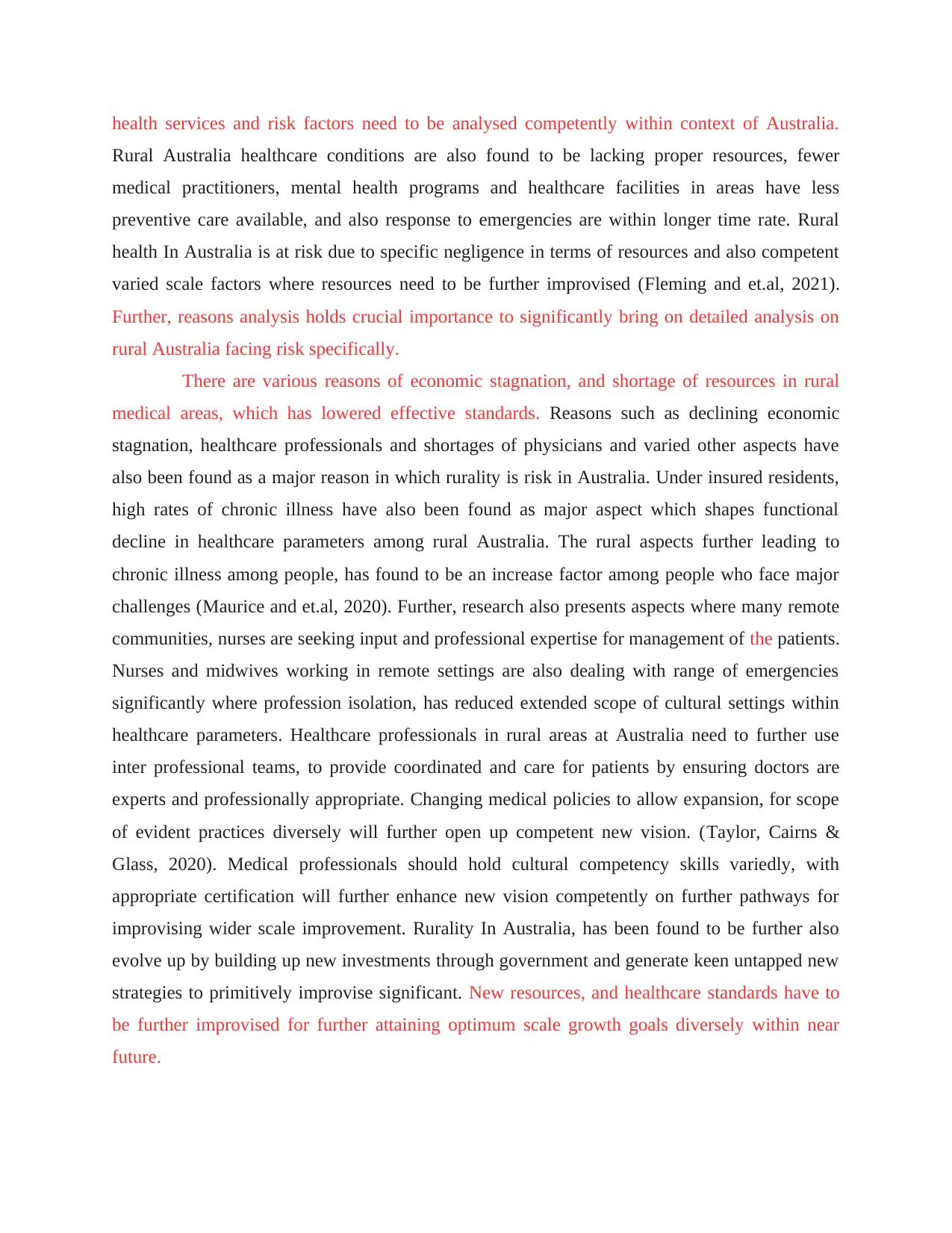
health services and risk factors need to be analysed competently within context of Australia.
Rural Australia healthcare conditions are also found to be lacking proper resources, fewer
medical practitioners, mental health programs and healthcare facilities in areas have less
preventive care available, and also response to emergencies are within longer time rate. Rural
health In Australia is at risk due to specific negligence in terms of resources and also competent
varied scale factors where resources need to be further improvised (Fleming and et.al, 2021).
Further, reasons analysis holds crucial importance to significantly bring on detailed analysis on
rural Australia facing risk specifically.
There are various reasons of economic stagnation, and shortage of resources in rural
medical areas, which has lowered effective standards. Reasons such as declining economic
stagnation, healthcare professionals and shortages of physicians and varied other aspects have
also been found as a major reason in which rurality is risk in Australia. Under insured residents,
high rates of chronic illness have also been found as major aspect which shapes functional
decline in healthcare parameters among rural Australia. The rural aspects further leading to
chronic illness among people, has found to be an increase factor among people who face major
challenges (Maurice and et.al, 2020). Further, research also presents aspects where many remote
communities, nurses are seeking input and professional expertise for management of the patients.
Nurses and midwives working in remote settings are also dealing with range of emergencies
significantly where profession isolation, has reduced extended scope of cultural settings within
healthcare parameters. Healthcare professionals in rural areas at Australia need to further use
inter professional teams, to provide coordinated and care for patients by ensuring doctors are
experts and professionally appropriate. Changing medical policies to allow expansion, for scope
of evident practices diversely will further open up competent new vision. (Taylor, Cairns &
Glass, 2020). Medical professionals should hold cultural competency skills variedly, with
appropriate certification will further enhance new vision competently on further pathways for
improvising wider scale improvement. Rurality In Australia, has been found to be further also
evolve up by building up new investments through government and generate keen untapped new
strategies to primitively improvise significant. New resources, and healthcare standards have to
be further improvised for further attaining optimum scale growth goals diversely within near
future.
Rural Australia healthcare conditions are also found to be lacking proper resources, fewer
medical practitioners, mental health programs and healthcare facilities in areas have less
preventive care available, and also response to emergencies are within longer time rate. Rural
health In Australia is at risk due to specific negligence in terms of resources and also competent
varied scale factors where resources need to be further improvised (Fleming and et.al, 2021).
Further, reasons analysis holds crucial importance to significantly bring on detailed analysis on
rural Australia facing risk specifically.
There are various reasons of economic stagnation, and shortage of resources in rural
medical areas, which has lowered effective standards. Reasons such as declining economic
stagnation, healthcare professionals and shortages of physicians and varied other aspects have
also been found as a major reason in which rurality is risk in Australia. Under insured residents,
high rates of chronic illness have also been found as major aspect which shapes functional
decline in healthcare parameters among rural Australia. The rural aspects further leading to
chronic illness among people, has found to be an increase factor among people who face major
challenges (Maurice and et.al, 2020). Further, research also presents aspects where many remote
communities, nurses are seeking input and professional expertise for management of the patients.
Nurses and midwives working in remote settings are also dealing with range of emergencies
significantly where profession isolation, has reduced extended scope of cultural settings within
healthcare parameters. Healthcare professionals in rural areas at Australia need to further use
inter professional teams, to provide coordinated and care for patients by ensuring doctors are
experts and professionally appropriate. Changing medical policies to allow expansion, for scope
of evident practices diversely will further open up competent new vision. (Taylor, Cairns &
Glass, 2020). Medical professionals should hold cultural competency skills variedly, with
appropriate certification will further enhance new vision competently on further pathways for
improvising wider scale improvement. Rurality In Australia, has been found to be further also
evolve up by building up new investments through government and generate keen untapped new
strategies to primitively improvise significant. New resources, and healthcare standards have to
be further improvised for further attaining optimum scale growth goals diversely within near
future.
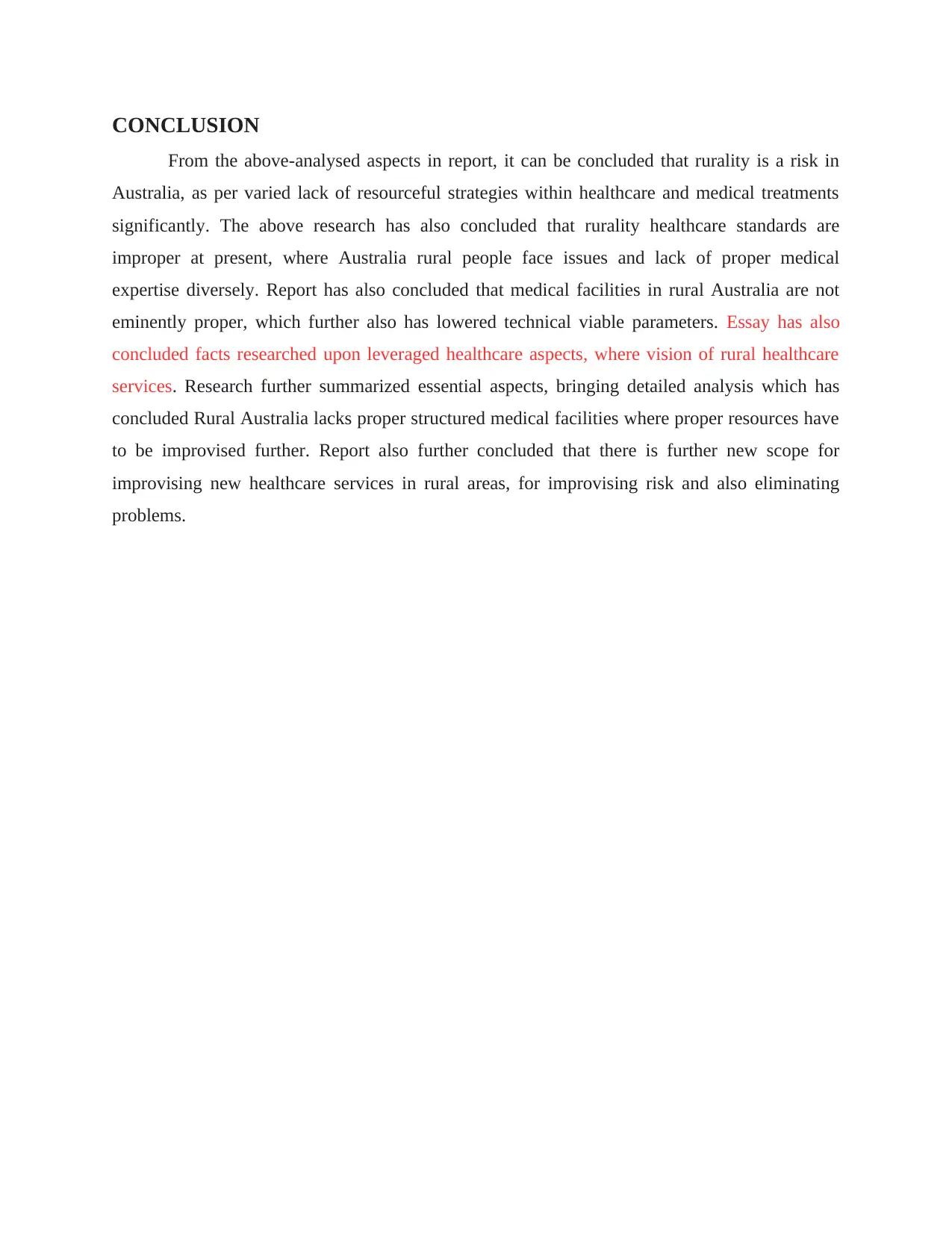
CONCLUSION
From the above-analysed aspects in report, it can be concluded that rurality is a risk in
Australia, as per varied lack of resourceful strategies within healthcare and medical treatments
significantly. The above research has also concluded that rurality healthcare standards are
improper at present, where Australia rural people face issues and lack of proper medical
expertise diversely. Report has also concluded that medical facilities in rural Australia are not
eminently proper, which further also has lowered technical viable parameters. Essay has also
concluded facts researched upon leveraged healthcare aspects, where vision of rural healthcare
services. Research further summarized essential aspects, bringing detailed analysis which has
concluded Rural Australia lacks proper structured medical facilities where proper resources have
to be improvised further. Report also further concluded that there is further new scope for
improvising new healthcare services in rural areas, for improvising risk and also eliminating
problems.
From the above-analysed aspects in report, it can be concluded that rurality is a risk in
Australia, as per varied lack of resourceful strategies within healthcare and medical treatments
significantly. The above research has also concluded that rurality healthcare standards are
improper at present, where Australia rural people face issues and lack of proper medical
expertise diversely. Report has also concluded that medical facilities in rural Australia are not
eminently proper, which further also has lowered technical viable parameters. Essay has also
concluded facts researched upon leveraged healthcare aspects, where vision of rural healthcare
services. Research further summarized essential aspects, bringing detailed analysis which has
concluded Rural Australia lacks proper structured medical facilities where proper resources have
to be improvised further. Report also further concluded that there is further new scope for
improvising new healthcare services in rural areas, for improvising risk and also eliminating
problems.
⊘ This is a preview!⊘
Do you want full access?
Subscribe today to unlock all pages.

Trusted by 1+ million students worldwide
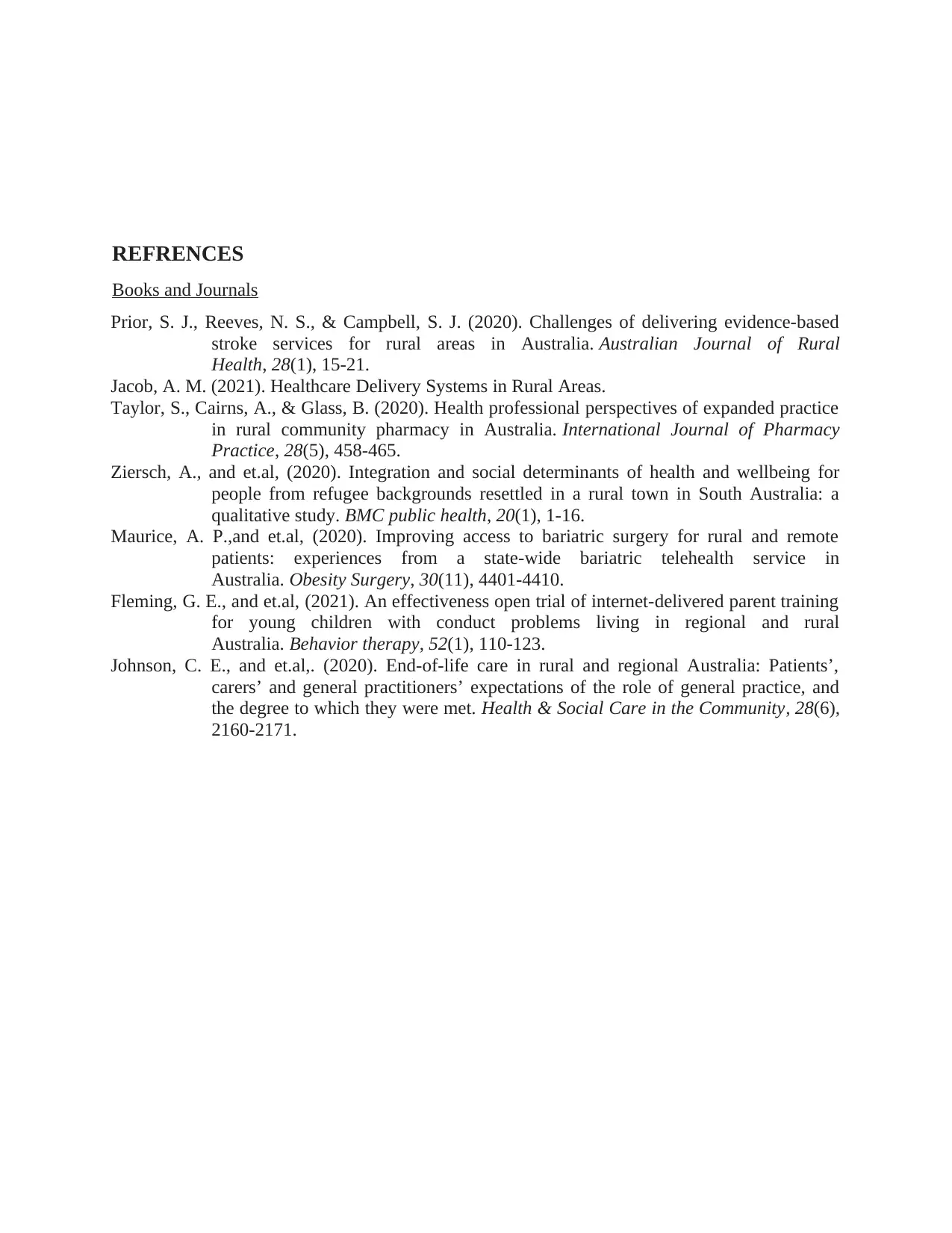
REFRENCES
Books and Journals
Prior, S. J., Reeves, N. S., & Campbell, S. J. (2020). Challenges of delivering evidence‐based
stroke services for rural areas in Australia. Australian Journal of Rural
Health, 28(1), 15-21.
Jacob, A. M. (2021). Healthcare Delivery Systems in Rural Areas.
Taylor, S., Cairns, A., & Glass, B. (2020). Health professional perspectives of expanded practice
in rural community pharmacy in Australia. International Journal of Pharmacy
Practice, 28(5), 458-465.
Ziersch, A., and et.al, (2020). Integration and social determinants of health and wellbeing for
people from refugee backgrounds resettled in a rural town in South Australia: a
qualitative study. BMC public health, 20(1), 1-16.
Maurice, A. P.,and et.al, (2020). Improving access to bariatric surgery for rural and remote
patients: experiences from a state-wide bariatric telehealth service in
Australia. Obesity Surgery, 30(11), 4401-4410.
Fleming, G. E., and et.al, (2021). An effectiveness open trial of internet-delivered parent training
for young children with conduct problems living in regional and rural
Australia. Behavior therapy, 52(1), 110-123.
Johnson, C. E., and et.al,. (2020). End‐of‐life care in rural and regional Australia: Patients’,
carers’ and general practitioners’ expectations of the role of general practice, and
the degree to which they were met. Health & Social Care in the Community, 28(6),
2160-2171.
Books and Journals
Prior, S. J., Reeves, N. S., & Campbell, S. J. (2020). Challenges of delivering evidence‐based
stroke services for rural areas in Australia. Australian Journal of Rural
Health, 28(1), 15-21.
Jacob, A. M. (2021). Healthcare Delivery Systems in Rural Areas.
Taylor, S., Cairns, A., & Glass, B. (2020). Health professional perspectives of expanded practice
in rural community pharmacy in Australia. International Journal of Pharmacy
Practice, 28(5), 458-465.
Ziersch, A., and et.al, (2020). Integration and social determinants of health and wellbeing for
people from refugee backgrounds resettled in a rural town in South Australia: a
qualitative study. BMC public health, 20(1), 1-16.
Maurice, A. P.,and et.al, (2020). Improving access to bariatric surgery for rural and remote
patients: experiences from a state-wide bariatric telehealth service in
Australia. Obesity Surgery, 30(11), 4401-4410.
Fleming, G. E., and et.al, (2021). An effectiveness open trial of internet-delivered parent training
for young children with conduct problems living in regional and rural
Australia. Behavior therapy, 52(1), 110-123.
Johnson, C. E., and et.al,. (2020). End‐of‐life care in rural and regional Australia: Patients’,
carers’ and general practitioners’ expectations of the role of general practice, and
the degree to which they were met. Health & Social Care in the Community, 28(6),
2160-2171.
1 out of 7
Related Documents
Your All-in-One AI-Powered Toolkit for Academic Success.
+13062052269
info@desklib.com
Available 24*7 on WhatsApp / Email
![[object Object]](/_next/static/media/star-bottom.7253800d.svg)
Unlock your academic potential
Copyright © 2020–2025 A2Z Services. All Rights Reserved. Developed and managed by ZUCOL.





